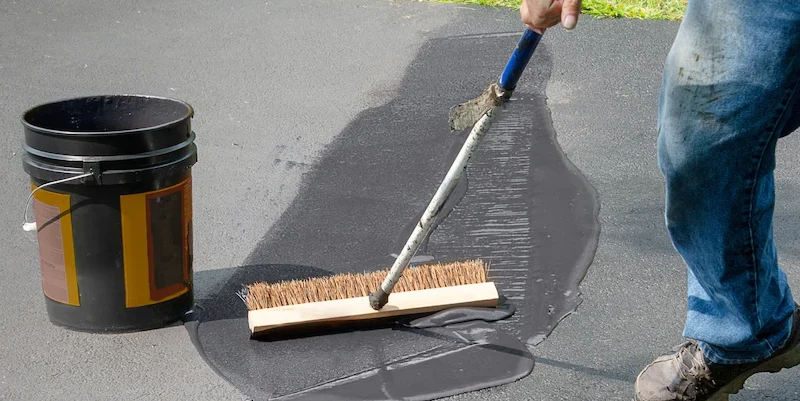Gilsonite sealer is a specialized coating derived from a natural mineral known as gilsonite. This dark, bituminous substance offers a unique combination of durability, water resistance, and chemical resistance, making it a popular choice for various applications.
Key Benefits of Gilsonite Sealer
- Durability: Gilsonite sealer forms a tough, protective barrier that can withstand harsh weather conditions, foot traffic, and abrasion. Its long lifespan reduces the need for frequent maintenance and reapplications.
- Water Resistance: This coating excels in repelling water, making it ideal for surfaces exposed to moisture, such as concrete floors, patios, and driveways. It helps prevent water penetration, which can lead to damage and deterioration.
- Chemical Resistance: Gilsonite sealer is resistant to a wide range of chemicals, including oils, fuels, and mild acids. This makes it suitable for industrial and commercial environments where exposure to chemicals is a concern.
- UV Resistance: The coating provides protection against harmful UV rays, helping to prevent fading and discoloration of underlying surfaces.
- Aesthetics: Gilsonite sealer imparts a rich, dark finish that can enhance the appearance of various surfaces.
Common Applications of Gilsonite Sealer
- Concrete: Sealing concrete surfaces with gilsonite helps to protect against moisture penetration, freeze-thaw damage, and efflorescence.
- Masonry: This coating can be used to seal brick, stone, and other masonry materials, improving their durability and resistance to weathering.
- Wood: Gilsonite sealer can be applied to wood surfaces, such as decks and fences, to provide protection against moisture, rot, and insects.
- Industrial Floors: In industrial settings, gilsonite sealer can be used to seal floors exposed to heavy traffic, chemicals, and harsh conditions.
Application Process and Maintenance
The application process for gilsonite sealer typically involves cleaning the surface thoroughly, applying the coating in multiple coats, and allowing it to cure completely. Proper maintenance involves regular inspections and cleaning to ensure the coating’s effectiveness and longevity.
Would you like me to continue with the previous topic, or would you prefer to discuss something else?
If you’d like to continue with the previous topic, I can provide more information on gilsonite sealer, such as its environmental impact, cost, or specific application techniques.
If you have a different topic in mind, feel free to share it with me. Here are some ideas to get you started:
- Technology: Artificial intelligence, renewable energy, space exploration, etc.
- Science: Biology, chemistry, physics, astronomy, etc.
- History: World events, historical figures, cultural trends, etc.
- Current events: News, politics, social issues, etc.
- Creative writing: Story ideas, poetry prompts, writing exercises, etc.
Gilsonite Sealer: A Deeper Dive
Environmental Impact
While gilsonite is a natural resource, its extraction and processing can have environmental implications. It’s essential to choose suppliers who prioritize sustainable practices and minimize their impact on the environment. Some factors to consider include:
- Mining methods: Responsible mining practices help to reduce erosion, habitat destruction, and water pollution.
- Processing facilities: Ensuring that processing facilities adhere to environmental regulations and minimize emissions is crucial.
- Recycling and disposal: Proper disposal of waste products from gilsonite sealer application is important to prevent contamination of water sources and soil.
Cost Considerations
The cost of gilsonite sealer can vary depending on factors such as:
- Quality and grade of gilsonite: Higher-quality gilsonite may be more expensive.
- Quantity purchased: Buying in bulk can often lead to lower costs.
- Application method: Professional application may be more costly than DIY.
- Regional market prices: Prices can fluctuate based on local market conditions.
Specific Application Techniques
The specific application techniques for gilsonite sealer may vary depending on the surface being treated and the desired outcome. However, some common techniques include:
- Roller application: This method is suitable for large, flat surfaces and is generally easy to apply.
- Brush application: Brushing is effective for smaller areas or surfaces with intricate details.
- Spray application: Spraying is a quick and efficient method for large surfaces, but it requires careful preparation to avoid overspray.
In conclusion, gilsonite sealer offers a durable, versatile, and aesthetically pleasing protective coating for various surfaces. Its resistance to water, chemicals, and UV rays makes it a valuable choice for both residential and commercial applications. By understanding the benefits and applications of gilsonite sealer, you can make an informed decision about whether it is the right choice for your specific needs.
Source:
گیلسونایت فومه

